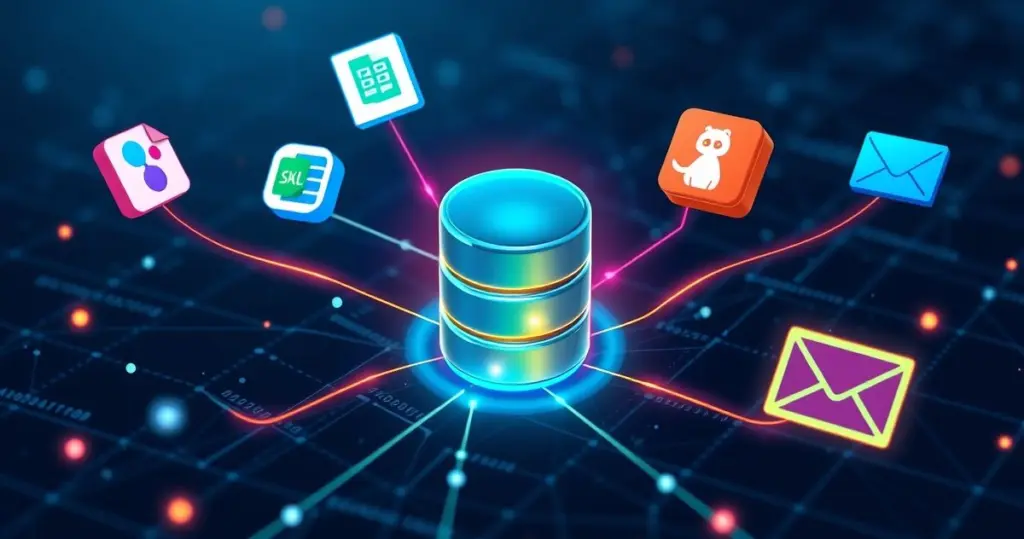To automate database tasks means using software to run recurring jobs like data synchronization, scheduled backups, or triggered updates without manual intervention. With n8n, you can easily connect to databases like PostgreSQL, MySQL, and SQL Server, and orchestrate workflows that not only query and modify data but also integrate it with hundreds of other applications. This allows you to build powerful, automated systems that sync customer data, generate daily reports, and even back up database objects on a schedule, all from a visual, low-code interface.
Why Automate Your Database with n8n, Anyway?
Let’s be honest. For years, the go-to methods for database automation were things like cron jobs running SQL scripts, or complex in-database triggers and stored procedures. I’ve spent my fair share of nights troubleshooting a finicky PowerShell script that was supposed to back up some views (a problem I see pop up in forums all the time). These methods work, but they often feel like building with mismatched Lego bricks. They’re siloed, require specialized coding skills, and can be a real headache to debug when they inevitably break.
Think of it this way: in-database triggers are like a robot that’s stuck in one room of your house. It can do its job perfectly within that room, like automatically turning on a light when you enter. But what if you want that robot to check the weather outside before deciding which light to turn on? It can’t. It’s trapped.
n8n is the robot that can roam the whole house, go outside, and even talk to the neighbors. It acts as a central orchestrator. It doesn’t just live in your database; it connects your database to everything else: your CRM, your communication tools like Slack, your file storage like Google Drive, and your email. This ability to create cross-application workflows is where you unlock the real magic of automation.
Common Database Workflows You Can Automate Today
You’re probably already thinking of a few tedious tasks you’d love to get off your plate. Here are some of the most common and high-impact database workflows you can build with n8n.
Data Synchronization and ETL
A classic use case is Extract, Transform, and Load (ETL). Maybe you have new leads coming in through a Google Sheet and you need them in your master PostgreSQL customer table. Or perhaps you need to migrate data from a legacy SQL Server database to a new system.
Instead of manual exports and imports, you can build an n8n workflow:
- Trigger: A Schedule node runs the workflow every hour.
- Extract: A Google Sheets node reads all new rows since the last run.
- Transform (Optional): A Code node cleans up the data—maybe standardizing phone numbers or capitalizing names.
- Load: A PostgreSQL node uses an
INSERTorUPDATEquery to add the new, clean data to your database.
This simple workflow ensures your data is always in sync, without you ever lifting a finger.
Scheduled Backups of Scripts and Objects
Remember that poor soul in the forum whose custom views and functions were getting wiped out by a software update? With n8n, you can create a disaster-proof backup system.
Imagine a workflow that runs every night:
- Trigger: Schedule node at 2 AM.
- Query: A SQL Server node runs a query against system tables (like
sys.sql_modules) to fetch the definitions of all objects prefixed withKLL_. - Format & Save: The workflow loops through each object, formats it as a
.sqlfile, and uses the GitHub node to commit it to a specific repository.
Now you have a version-controlled history of all your custom database code, completely automated.
Real-World Case Study: Automating a Daily Sales Report
I once worked with a sales manager, let’s call her Sarah, who spent the first 30 minutes of every single day on a soul-crushing task. She would run a query on their sales database, export the results to a CSV, wrangle it into a pivot table in Excel, and finally email a summary to the leadership team. Sound familiar?
Here’s the five-minute workflow we built in n8n to give her that time back:
- The Trigger: A Schedule Node set to run every weekday morning at 8:00 AM.
- The Query: A PostgreSQL node connected to their sales database. It ran a pre-written SQL query that aggregated the previous day’s sales by product and region. The beauty here is the query does the heavy lifting.
- The Check: An If node to make sure there was actually data to report. No sales, no report. Simple.
- The Report: If sales existed, a Spreadsheet File node took the JSON data from the query and created a nicely formatted XLSX file.
- The Delivery: The workflow then branched. An Outlook node emailed the spreadsheet as an attachment to the leadership team, while a Slack node posted a friendly summary (
"Morning team! Yesterday's sales report is in your inbox. We did $15,420 in total revenue! :tada:") to the main sales channel.
The result? Sarah got 2.5 hours back every week, the reports were always on time and error-free, and the whole team got instant visibility. This is what it means to truly automate a database workflow.
n8n vs. In-Database Tools: Which is Right for You?
So, when should you use n8n and when should you stick with a traditional database job or trigger? It depends on the context.
| Feature | n8n Workflow | In-Database Triggers/Jobs |
|---|---|---|
| Connectivity | Excellent. Connects to hundreds of external APIs and services out of the box. | Poor. Generally limited to the database environment itself. |
| Ease of Use | High. Visual, low-code interface. Basic logic requires no code. | Low. Requires proficiency in SQL, PL/SQL, T-SQL, PowerShell, etc. |
| Visibility | Excellent. Visual execution log shows every step, input, and output. | Poor. Debugging often involves reading obscure logs or querying system tables. |
| Error Handling | Flexible. Built-in retry logic and the ability to run custom error workflows (e.g., send a Slack alert). | Rigid. Often fails silently or requires complex TRY...CATCH blocks. |
| Use Case | Ideal for processes that involve multiple systems (e.g., DB -> Slack -> CRM). | Best for tasks that are entirely self-contained within the database (e.g., updating a modified_at timestamp). |
Your First Steps to Automate a Database
Ready to dive in? Don’t try to boil the ocean. Start small.
1. Connect Your Database
In n8n, go to the Credentials section and add the credentials for your database. n8n stores these securely, so you don’t have to hardcode them into your workflows. It’s the first step towards safe and scalable automation.
2. Build a Simple “Read” Workflow
Create a new workflow with a Manual trigger. Add your database’s node (e.g., Postgres) and configure it to run a simple SELECT * FROM users LIMIT 10;. Run it. Seeing that data pop up in the output panel is a fantastic first win and confirms your connection is solid.
3. Find Your Repetitive Task
Now, think about your daily work. What’s that one report you run, that one data entry task you do, that one number you check every single day? That is the perfect candidate for your first real database automation workflow.
Automating your database isn’t just about saving time; it’s about making your data more powerful. By connecting it to the rest of your tools with n8n, you’re not just running queries—you’re building an intelligent, interconnected system that works for you.

